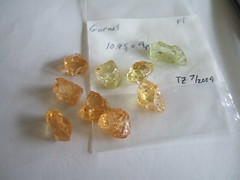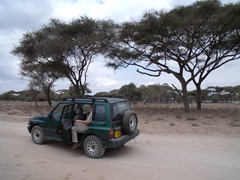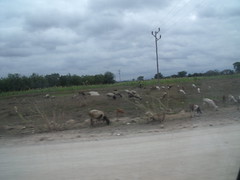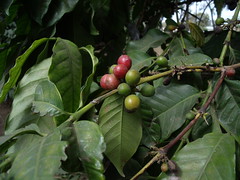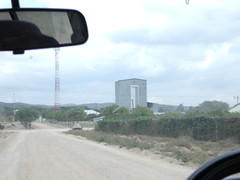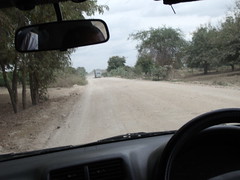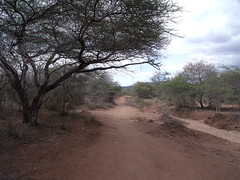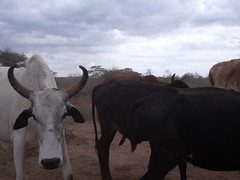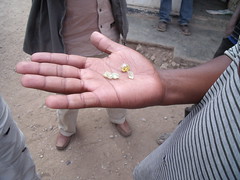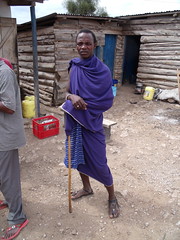Tanzania Buying Trip, Day 4 – 5 July 2009
The first few days of our trip we spent in our broker’s (Jamal’s) office reviewing and buying stones — aside from the fact that every lot had to be priced by bartering, we could have been sitting in any other gem trading area doing the same work. But today we were heading into the bush, well away from anything I had done before. It was the first time I started seriously thinking “Hey, I’m really in Africa!”
Apart from the Maasai walking around in traditional dress, Arusha could be mistaken for any other city in the third world. It’s dirty, the roads are really bad, the sidewalks cavernous, and there are all sorts of things to jar common American sensibilities. But once you’re away from the city, things begin to look quite different and very distinct: it’s Africa.
A few days ago, some fellow gem traders told us about a village not too far from Arusha called Lolatema. It turned out that we had the name wrong as Lolatema refers to a mountain range, but the info was all we had to go on. We were told they mine yellow and light minty green grossular garnets and there was some potential to buy some rough at the local market. The day before our trip (and before I knew we were going to the mine area), we saw a parcel of pastel grossular garnets from Lolatema and I was able to purchase some:
Each stone in this image is around 1 gram — and they all glow like only clean grossular garnet can.
We told our broker about our information on Lolatema hoping that he could add some insights. He was generally familiar but hadn’t been there himself. Then he offered to take us into the bush to find the place and visit. We were grateful to have someone along who knew both how to navigate the bush and the local cultures. (I was especially glad — our broker is patient, generous to a fault, and well connected — the uncle I wish I had. If we were going to get stuck or lost in the area, he’s the guy I’d want along!)
We met relatively early the next morning. Our broker was bundled up as it if was mid-Autumn in NY, though the temp couldn’t have been much below 70F. We were traveling in his little Suzuki, so Rog & I sat in back and Gene went shotgun.
As best we could locate Lolatema on a map, it seemed our best route was through Merelani, or Mererani as it is locally called. Mererani about an hour and a half ESE of Arusha and directly south of the Kilimanjaro airport. This means we used the same road we took to Arusha from the airport — I was grateful for this as the last time we were over that road, it was very dark. Along the way, we passed various tourist camps, small towns, aid projects, and coffee plantations. It’s the route a tourist would take from the airport to any of the safari operations around Arusha. It was fascinating to look around — our poor broker must have been bored with everything we pointed out & had him explain.
Cattle, sheep and goats area allowed to graze along side of any road. These were along side one of the better roads where we could go about 50kmh. Happily, the animals seemed quite used to the traffic and not inclined to spook.
These are the other gems I found on the trip, though I didn’t bring any back. Home coffee roasting is my sole remaining hobby since gem cutting became a trade… The others were kind enough to suffer my eccentricity by stopping the car (twice) while I gaped at the glorious rows of verdant and red beans…
Mererani is a controlled town, overseen by the Tanzanite One corporation. Foreigners need special permits to get into the town. The permits are $50 and available from the Ministry of Mines, but as we weren’t intent on Mererani, so we didn’t get the permits ahead.
We headed to the one of the entrances to Mererani where we hoped to get permission to pass through the town, but it turned out that there was a new gate up our broker wasn’t aware of, complete with an armed guard who wasn’t going to be sweet-talked. So we were turned away from the obvious route to the Lolitema area.
Since we couldn’t go through Mererani, we had to figure another route to the Lolatema. This involved talking with a lot of Maasai and plenty of phone calls to local friends who were more familiar with the bush in this area.
Now, from this point the trip became really interesting because we had to go from “good” roads to really driving around the bush. For some perspective: the road from Arusha to the Kilimanjaro airport is paved and quite fast (though they control speed by using speed-bumps near towns). But once we turned off of the paved road, we drove on dirt or gravel roads, but they were still quite good by local standards. These “good” roads reminded me of the gravel roads called “seasonal use roads” here in NY. At one point on the gravel road I saw a sign that read something like “This road proudly constructed and maintained by Tanzanite One”. Well, I laughed that off as a bit of corporate propaganda on my way into the bush, but not on the way out…
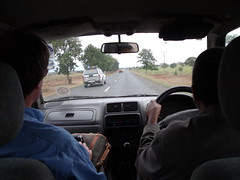
Main road from Arusha toward Kilimanjaro airport.
“Constructed and maintained by Tanzanite One”
It’s hard to describe the “roads” in the bush — though if you’ve hiked or driven on an old, washed-out logging road you’ll have the right idea. Gene observed that the roads were so rugged that they were the kind of thing that the off-road enthusiasts would pay good money to be allowed to run over. Jamal took that little Suzuki over and around things I never would have thought the little car could do. Oh, and to get a more complete picture, you’ll have to add a whole lot of billowing dust, random herds of cattle, and snickering Maasai who clearly thought we were crazy.
It’s worth clicking on this one to see the larger image — just after I took this, we headed down the road into and through the washout that is just barely visible beneath the tree. The whole trip was like this — and it was a blast.
The Maasai steppe is high desert and the area was in drought, so our trip through the bush was incredibly dusty. It was a mostly cloudy day, but I had to keep my sunglasses on keep the dust from pushing straight into my eyes. It occurred to me that given the amount of dust I ingested on the trip, I might have a legal obligation to declare myself at the Ministry of Mines.
The scenery throughout was amazing. Apart from birds, there were not many wild animals to be seen. We spooked a couple ground squirrels. I think I saw a fox at one point. There were a few dik dik (think tiny deer), and we had on encounter with a rather larger animal that we surprised on the track. It was about the size of a larger north-eastern white-tail buck, and it had zebra-like stripes on it’s hindquarters. We later debated exactly what it was we saw (maybe a gerenuk?). I wish I could have been ready with the camera, but we only saw it for a second at most.
There were more domestic animals in abundance. We were driving through the Masai steppe, so there were a lot of boys driving herds of goats or cattle from place to place.
We saw all sorts of people of all ages, nearly all dressed in the brightly colored plaid or stripes that seems to distinguish the Maasai. The Masai women were impressive — they all wear short hair, like the men, but they colors of their clothes are brighter or perhaps more varied. The older women (of status, I guess) tend to have a lot of dangley earrings and one or several chains about their necks — they also glare severely if you look like you’re pointing a camera at them… These girls were not paying attention quite as closely:
We traveled for a good hour into the bush, dodging wash-out, stumps, rocks, gullies, goats, cattle and the occasional musk ox. Finally, we came to the Lolatema mountains — the village of Longosse. It was a small village spread over a large area. Since it was Sunday, some people were at church, but many were just loitering around the mud houses. There were plenty of children running about and animals all over.
Our broker stopped to ask for specific directions to the mines. He received them, but it took some small talk. Once one of the locals figured out what we were doing, he produced a small parcel of garnets for us. They were small chips, but all of the same type I had purchased the day before in Arusha. There was nothing we wanted to buy, but it confirmed we were in the right place. Unfortunately, there was no indication of a market anywhere to be seen.
We followed the directions out of the village, but still well within the thorn-fences erected to keep the cattle in the area. We were directed toward a granite mountain that wasn’t very distant. We got about a kilometer or so when the road became very uneven and the directions were not clear enough to make us confident in choosing a path. We stopped there to stretch and poke around. There wasn’t much to see — but there were tiny garnets in the nearby streambed and a tantalizing vivid green of some small tourmaline in a calcite matrix someone had used to stop some erosion on the path. Clearly there were interesting things to be found somewhere in the area.
I’m very confident that the hill in the background is part of the mining area. The shape fits the description we were given of the Lolatema deposit and the tracks on the path here looked like someone had a tractor or drawn cart taken up and down the road. Unfortunately, it was getting late and the three of us began to have the distinct feeling that it wasn’t a good idea to press on. I believe our guide would have accommodated us, but it seemed wise to stop at this point: we wanted to get back to Arusha before dark.
On the way out of the village, our guide stopped at the local (and only) shop. It was a small hut with a couple slightly larger buildings nearby. A couple guys in western dress and one in traditional garb were there, along with a couple chickens and a goat. Our guide chatted with them a bit and then came back to ask if we wanted anything from the shop. Slow on the pick-up, we all declined — only to get a frustrated “oh, c’mon…” from our broker who went back to buy a Fanta for himself. Then it clicked. Suddenly, we all wanted soda and crackers. Sure enough, four Fantas and several packages of crackers were enough to make the store owner produced a small parcel of grossular garnets. I had first dibs.
This is the first offering of grossulars we were shown — there were some nice colors, but, unfortunately, all of them had problems. Well, all except one, which was safely in my pocket by the time I took this pic. The one stone I was able to buy was about 1.2grams, very clean and nicely shaped — and the price was well below what I paid in Arusha.
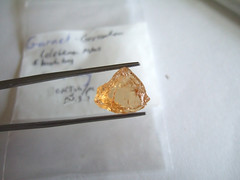
(You can see surface features here, but the stone is clean.)
My purchase made it clear that there was some money to be had, so the shop-keep produced some more stones. First up, was a large bag of small chips and chibbles. I don’t think any of us looked at it closely as, generally speaking, anything that comes in a large bag is probably not for us. Then, after some hurried discussion with his colleagues, he produced some rather fine minty green grossular. The starting price made it obvious that his hopes were set far too high. But Gene took some time to look things over and tried to negotiate a bit. Unfortunately, things didn’t work out, so we were not able to buy anything else from the village.
Our friend, broker & guide translating, trusty phones in hand.
I got permission to take this picture as Gene was negotiating with the merchant. From other pictures I’ve seen, it’s men like him, dressed pretty much just like this, are the ones working the mountain with hand tools to extract the garnets. That thought gives me pause as I seldom dig without jeans, stiff boots, gloves, hat and whatever lotions I need to keep the pests & sunburn at bay. If nothing else, Maasai are tough.
The trip back after that was faster as we had a better idea of the way. In winter, Tanzania has a lot of high cloud cover. So I was very happy to see things clear out a bit so we could see the top of Kilimanjaro clearly.
We also saw a series of dust-devils swirling over the plains. Sadly, the Kilimanjaro area is in drought, so the wind has it’s way with what should be farm fields.
Getting back to Arusha was uneventful. We stopped at the Arusha Hotel (an expensive hotel housing a great little coffee shop, happily open to the public). It was good to stand after being bumped around the bush for 8 hours. Sitting in an oversized, soft chair with a very fresh cup of french press helped a lot too.
Someday, I’ll do it again.



